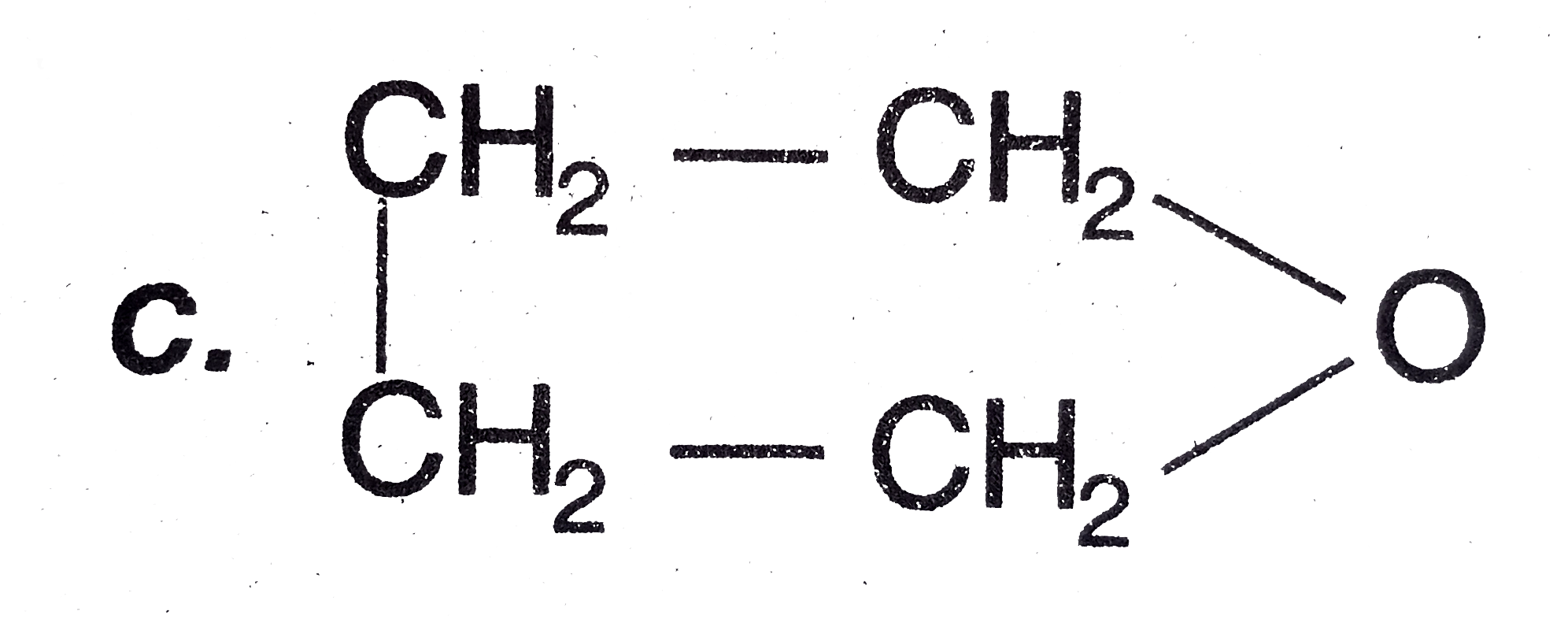A and B are

None is correct
The correct Answer is:B
To solve the problem, we will follow the steps outlined in the video transcript and break down the reactions step by step.
Step 1: Reaction of CH₃CN with CH₃MgBr
1. Starting Material: We have CH₃CN (acetonitrile), which contains a carbon atom triple-bonded to a nitrogen atom.
2. Nucleophilic Attack: The Grignard reagent CH₃MgBr acts as a nucleophile. The carbon atom in the nitrile (C≡N) is electrophilic due to the electronegative nitrogen atom pulling electron density away from it.
3. Formation of an Intermediate: The nucleophilic CH₃ group from CH₃MgBr attacks the electrophilic carbon of the nitrile, resulting in the formation of an intermediate:
CH₃C(=N)MgBr
This intermediate has a carbon double-bonded to nitrogen and a magnesium bromide group attached.
Step 2: Hydrolysis of the Intermediate
1. Hydrolysis: When we add H₃O⁺ (acidic hydrolysis), the intermediate undergoes hydrolysis. The nitrogen atom will attract a hydrogen ion from water, leading to the formation of an amine and a carbonyl compound:
CH₃C(=O)CH₃+NH₄++MgBr−
Here, we have formed an amide (CH₃C(=O)NH₂) and a byproduct of ammonium ion and magnesium bromide.
Step 3: Conversion of A to B using Concentrated H₂SO₄
1. Formation of B: The amide (A) can be treated with concentrated sulfuric acid (H₂SO₄), which will lead to dehydration and the formation of an imine or an amide derivative:
CH₃C(=O)NH₂H₂SO₄→CH₃C(=O)+H₂O
This step results in the formation of a ketone (B).
Final Products
- A: The product after the first reaction and hydrolysis is Acetamide (CH₃C(=O)NH₂).
- B: The product after dehydration using concentrated sulfuric acid is Acetone (CH₃C(=O)CH₃).
Summary
- A: Acetamide (CH₃C(=O)NH₂)
- B: Acetone (CH₃C(=O)CH₃)
1. Starting Material: We have CH₃CN (acetonitrile), which contains a carbon atom triple-bonded to a nitrogen atom.
2. Nucleophilic Attack: The Grignard reagent CH₃MgBr acts as a nucleophile. The carbon atom in the nitrile (C≡N) is electrophilic due to the electronegative nitrogen atom pulling electron density away from it.
3. Formation of an Intermediate: The nucleophilic CH₃ group from CH₃MgBr attacks the electrophilic carbon of the nitrile, resulting in the formation of an intermediate:
CH₃C(=N)MgBr
This intermediate has a carbon double-bonded to nitrogen and a magnesium bromide group attached.
1. Hydrolysis: When we add H₃O⁺ (acidic hydrolysis), the intermediate undergoes hydrolysis. The nitrogen atom will attract a hydrogen ion from water, leading to the formation of an amine and a carbonyl compound:
CH₃C(=O)CH₃+NH₄++MgBr−
Here, we have formed an amide (CH₃C(=O)NH₂) and a byproduct of ammonium ion and magnesium bromide.
1. Formation of B: The amide (A) can be treated with concentrated sulfuric acid (H₂SO₄), which will lead to dehydration and the formation of an imine or an amide derivative:
CH₃C(=O)NH₂H₂SO₄→CH₃C(=O)+H₂O
This step results in the formation of a ketone (B).
- A: The product after the first reaction and hydrolysis is Acetamide (CH₃C(=O)NH₂).
- B: The product after dehydration using concentrated sulfuric acid is Acetone (CH₃C(=O)CH₃).
- A: Acetamide (CH₃C(=O)NH₂)
- B: Acetone (CH₃C(=O)CH₃)
Topper's Solved these Questions
- ALDEHYDES AND KETONES BOOK - FIITJEECHAPTER - ALDEHYDES AND KETONES EXERCISE - ASSIGNMENT PROBLEMS (OBJECTIVE) LEVEL - II
24 Videos
- ALDEHYDES AND KETONES BOOK - FIITJEECHAPTER - ALDEHYDES AND KETONES EXERCISE - ASSIGNMENT PROBLEMS (OBJECTIVE) COMPREHENSION-I
5 Videos
- ALDEHYDES AND KETONES BOOK - FIITJEECHAPTER - ALDEHYDES AND KETONES EXERCISE - ASSIGNMENT PROBLEMS (SUBJECTIVE) LEVEL - II
1 Videos
- ALCOHOLS, ETHERS AND PHENOLS BOOK - FIITJEECHAPTER - ALCOHOLS, ETHERS AND PHENOLS EXERCISE - SINGLE INTEGER ANSWER TYPE QUESTIONS
7 Videos
- ALKYL AND ARYL HALIDESBOOK - FIITJEECHAPTER - ALKYL AND ARYL HALIDESEXERCISE - NUMERICAL BASED QUESTIONS
1 Videos
Similar Questions
Knowledge Check
Compounds (A) and (C ) in the following reactions are
CH3CHO(i)CH3MgBr−−−−−−−−→(ii)H2O(A)H2SO4,Δ−−−−−−→(B)Hydroboration oxidation−−−−−−−−−−−−−−→(C)AidenticalBpositional isomersCfunctional isomersDoptical isomers.CH≡CHCH3MgBr−−−−−→A(i)CO2−−−−−−→(ii)H3O+BHgSO4/H2SO4−−−−−−−−−→
O∣∣HO−C−CH2−O∣∣C−OH(i)[Ag(NH3)2]+,OH−−−−−−−−−−−−−−−−−→(ii)H+C
In the given, reaction, product C isA B
B C
C D
D
Consider the following reaction sequence ,
CH3CH(OH)CH3ConcH2SO4−−−−−−−−→HeatXdil.H2SO4−−−−−−−−→H2OY
X and Y in the reaction respectively areACH3CH=CH2,CH3CH(OH)CH3BCH3CH=CHCH3,CH3CH2CH2OHCCH3CH2CH=CH2,CH3,CH2CH2OHDCH3CH2CH2CH3,CH3CH(OH)CH2CH3
Predict the products:
(i) CH3CH2OHK2Cr2O7−−−−−→H2SO4ASOCl2−−−→BNH2−−→CNaOBr−−−→D
(ii) CH3CH2ClKCN−−→AOH−−−→H2O2BP2O5−−→C
(iii) CH3COOHC2H5OH−−−−−−→concH2SO4ACH3MgBr−−−−−→H+/H2OBCH3MgBr−−−−−→H2∅H+C
View Solution(CH3)2+HCN→[A]H3O+−−−→[B]H2SO4−−−→Heat[C]
View SolutionIn the given reaction
CH3−CH2−C∣∣NaOH−CH3H2SO4−−−−−−−−−−→(H2O/H+),Δ(A)+(B)
A and B are:
View SolutionIn the reaction
CH3−C≡C−HCH3MgBr−−−−−→CH4+(A)(i) CO2−−−−−−−−−−→(ii) H2O/H⊕(B) (B) will be
View SolutionThe main organic product of the reaction
CH3−CH3| C | CH3−OHKBr/H2SO4(conc.)−−−−−−−−−−−−→ is
View Solution

